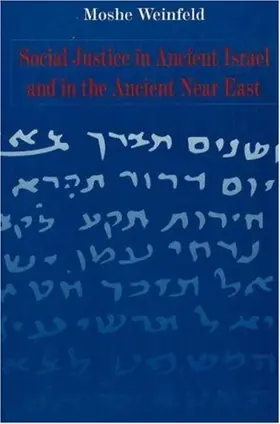

Social Justice in Ancient Israel and in the Ancient Near East
Pages
300
Publisher
Magnes Press
Published
1/3/1995
ISBN-13
9780800625962
Reviews
Social Justice in Ancient Israel and in the Ancient Near East Jerusalem: Magnes/Minneapolis: Fortress, 1995. Pp. 300, Cloth, $34.00, ISBN 080062596X. Daniel L. Smith-Christopher Loyola Marymount University Los Angeles, CA 90045 Professor Weinfeld's book, originally published in Hebrew in 1985, is here translated and revised for an English-language edition jointly published by Magnes and Fortress Presses. The appearance of this volume is to be celebrated, not only because of the intrinsic value of the work itself, but also for the other studies that will surely be generated by Prof. Weinfeld's work now that it can have a wider audience. In this very interesting work, Weinfeld attempts to locate the social justice emphasis of the Hebrew Bible within its ancient Near Eastern context. He focuses his study by concentrating on the terms m$p+ wcdqh and the related terms in documents from surrounding cultures, including Ugaritic, Hittite, Akkadian, and Egyptian, from as early as the third millennium BCE down to the hellenistic period. Although the references are helpful throughout the book, Weinfeld's examination of texts is not highly critical, and scholars seeking a detailed linguistic examination of the cited texts may be disappointed. The value of Weinfeld's work is therefore not as a critical, linguistic, or even historical examination of texts, but rather as an introduction to the development of conceptual links between ancient Near Eastern cultures, including that of the ancient Hebrews. The sweep of his study is nonetheless impressive and lends strength to his arguments, because they seem to be relevant for the entire first millennium BCE, covering virtually all proposed dates for biblical material. A review of the chapter headings serves to summarize the direction of his analysis. He begins his analysis in chapter 1, entitled "Justice and Righteousness," with an examination of the terms mp+ wcdqh $ and a comparison of them with the misharum of Mesopotamia. This establishes the main direction of his study: Weinfeld argues that the practice of offering "liberation," either at the accession of a new ruler or at the granting of special status to temple cities (Sippar, Babylon, etc.), is the conceptual background against which the biblical concepts of "justice and righteousness" must be read and understood.
[Full Review]
